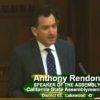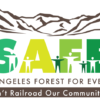Bills being introduced that monitor or change terms for the high-speed rail project are a rarity. However there are two bills brewing in the Legislature. One has a shot at passing, the other doesn’t.
Senators Andy Vidak (R) Hanford and Rudy Salas (D) Bakersfield have sponsored SB 3 and Sacramento observers predict it won’t pass. It’s asking the Legislature to approve putting the high-speed rail back on the ballot. If passed it would re-direct high-speed rail funds to retiring the debt incurred from the issuance and sale of bonds already spent. It also requires that unsold bonds use 50 percent of the net proceeds for funding repair and new construction projects on state highways and freeways. The remaining 50 percent would be used to fund repair and new construction projects on local streets and roads.
Bill sponsor Senator Andy Vidak, R-Hanford told the Signal, “The high-speed rail of today is not what the voters approved in 2008,” In addition he said, “Californians deserve the right to re-vote on this massive transportation project that could end up costing hundreds of billions of dollars if it is ever completed.”
The other bill, SB 400 (Lara), is another story. It has a chance of passage. It has been moving slowly through committees since February. It is being carried by Senator Ricardo Lara (D- parts of LA County and Long Beach) and originated from the very powerful Hispanic caucus. The bill requires the HSRA to use at least 25% of its C&T funds for projects that either reduce or offset construction emissions today.
Note: The Legislature passed SB 862 back June of 2014 that allowed High-Speed Rail to receive 25% of the revenues of Cap-and-Trade Auctions on a continuous basis. SB 400 would effectively reduce construction funds to 18-¾% of Cap and Trade revenues.
SB 400 has passed in the Senate and is in the Assembly, awaiting its final fate.
According to the Senate analysis the bill requires the California High-Speed Rail Authority (HSRA) to allocate funds appropriated to project that either “reduce or offset greenhouse gas (GHG) emissions directly associated with the construction of the high-speed rail project and provide a co-benefit of improving air quality.”
It suggests that this bill might save the Cap-and-Trade program currently being challenged by two lawsuits. The first one is by Pacific Legal Foundation. It is on appeal and expected to be heard in the fall. It claims that the very existence of the cap-and-trade program is an illegal tax.
The second suit is by TRANSPORTATION SOLUTIONS DEFENSE AND EDUCATION FUND (TRANSDEF) that suit proposes that the High-Speed rail project fails to meet the requirements of AB-32. It will not be operational by 2020, which is the deadline to reduce the GHG emissions to 1990 levels.
In SB 400 senate analysis it reports that “the Constitution requires that a clear nexus exist between an activity for which a mitigation fee is used and the adverse effects related to the activity on which that fee is levied.” They also say, “it is important that legislation allocating cap-and-trade revenues ensure that the funds are being used to reduce GHG emissions. If opponents of the program can convince the courts that the revenues are not being used appropriately, the entire cap-and-trade program could be jeopardized.”
In effect they are hinting that rail program funding perhaps doesn’t meet standards and with passage of this bill, it might help win the court cases. The bill suggests that if enacted, these changes could actually save the actual program, which is predicted to bring in as much as $2 billion a year in fees.
The Assembly analysis is sympathetic but not as positive as the Senate was. The Assembly predicts the passage of the bill will significantly drive up the cost of the project, which could threaten the completion of the project and jeopardize any future environmental benefits. It admits that funds for the project are deficient and this bill would reduce the only stable revenue stream the project has.
The Assembly’s analysis also points out that SB 400 is intended to offset environmental impacts due to construction but does not impose any requirement that the re-directed dollars, approximately $125 million dollars, be spent in communities near the construction zones. They say the bill could result in “millions of dollars being spent in Southern California, hundreds of miles from the high-speed rail construction sites.”
In other words they are suggesting it could be a money grab for other transit projects in Southern California and not used for the disadvantaged targets it proposes in the bill.
Republicans in the Legislature have been unsuccessful for the past 3 years with approximately 13 bills that attempted to manage, change or end the high-speed rail program. All failed to get out of committee due to party line votes. In fact Assembly Member Jim Patterson, author of a couple of rail bills, has a graveyard with little tomb stones set up in his backyard for failed bills he’s introduced on various subjects including high-speed rail.
Despite the fact that SB 3 is co-sponsored by Senators Andy Vidak (R) Hanford and Rudy Salas (D) Bakersfield, it’s expected to suffer a similar fate.
However Sacramento insiders predict that SB 400 it is expected to pass but they expect the Governor will veto the bill. If he does and the court cases are lost because of non-compliance with cap-and-trade regulations, California’s Democratic legislature could point the Governor’s decision as the cause, their hands will be clean.




